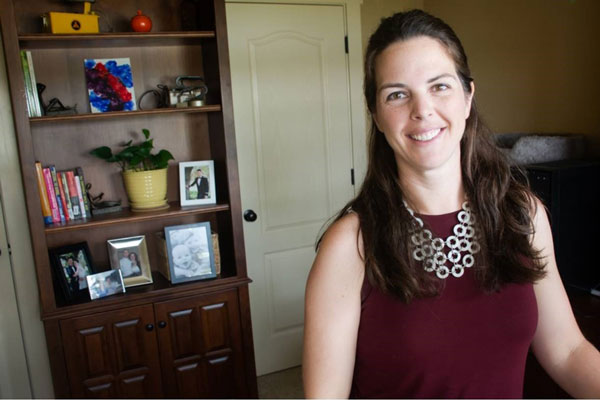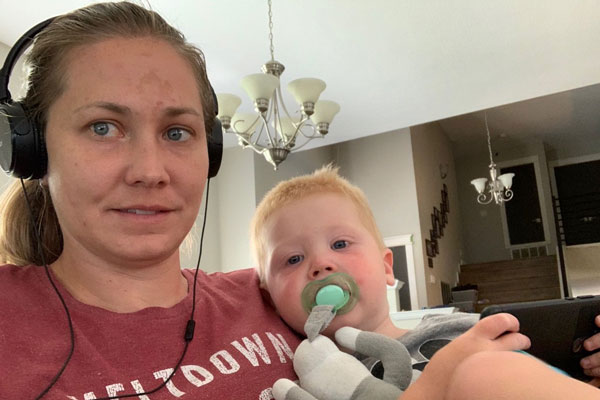Sandia resources, support networks enable remote work
See below: Parent Relief Project
With school closures, partial reopenings, at-home learning and uncertainty due to the COVID-19 pandemic, Sandia parents are finding ways to meet their work commitments while balancing the unique needs of their family schedules, including taking advantage of Sandia resources, receiving management support and finding outside networks. Sandia parents have shared with Lab News what works for them.
Finding balance
Supporting Human Resources, program communications specialist Lara Adams is working from home part-time while parenting two sons. As with many other parents, she finds that her schedule has shifted to balance work, school, personal time and housework.
“Both of my sons are attending school online,” she said. “My oldest, ninth grade, is handling online school surprisingly well, although he’d rather be going in person. My seventh grader has autism and needs an educational assistant to keep him on task and help with classwork. His teacher and classroom EAs do their best to keep him engaged virtually, but it falls on me to be his in-person EA.”
Lara tries to find time to take a walk or do yoga during the day and, she said, “I’m incredibly fortunate to be able to do my job from home and grateful that my management supports telecommuting and flexible work hours.
“My core workday and meeting availability has shortened to noon to 6 p.m., so now I have to work evenings and weekends to get everything done on top of housework and finishing up schoolwork, which means I have a hard time finding time to take care of myself. Because I’m working such odd hours, and at home it is so easy to just keep working, to just finish this one last thing, then another last thing, and so on, it’s hard to call it quits for the day.”
Moving during a pandemic

A systems analyst in Sandia’s Human Factors department, Megan Greenwald-Yarnell has been at Sandia for two years and had just returned from maternity leave in January. Then the COVID-19 pandemic arrived. “I was just getting my feet under me in March when we all started working off-site,” she said. Megan has two children: a 3-year-old and an infant.
“At first, we pulled (the kids) both out of daycare because we didn’t know what to do. My husband and I are both very logical so it was hard to do that risk calculation that quickly. So, we panicked and we decided to keep them at home, and it was so hard. We had them at home for about two weeks. The first week, we tried to do it completely ourselves.”
The children returned briefly to daycare, and then their family had to make an enormous change in the midst of the pandemic.
Megan’s husband is a major in the U.S. Air Force, and they have relocated frequently. Over the summer he was transferred from New Mexico to Maxwell Air Force Base in Alabama. “Relocating during the pandemic was really hard. My husband and I move a lot, and we had moved once before with a kid. We kind of thought we knew what we were doing, but it’s so much more difficult when you’re trying to adhere to social distancing guidelines and keeping the kids safe and minimize the places that you take them,” she said.
Finding time for herself and occasionally getting out of the house for short outings has helped Megan manage the stress of the transition. She also hired a nanny to provide in-home childcare so she and her husband can focus on work during the day and not risk sending the children to daycare. “There’s a relief in knowing I can shut my office door and do some work and have some peace and quiet.”
Sandia couple balances remote work, parenting

As a coordinator of the Sandia Parents Group monthly lunch-and-learn series and a mother of three young children, systems engineer Lindsey Gloe Hughes also understands the challenges that parents are facing while working from home. She has been with Sandia for 10 years and recently transitioned to her new role from her previous job as a technologist in the organic materials group. “It’s been an added layer of chaos with the pandemic,” she said. Her husband Brice, a mechanical engineer, also works for Sandia.
Lindsey works part-time to balance work and the needs of her 6-, 4-, and 2-year-old children. Managing the kids’ school schedules, especially for their first grader, has been so hectic that they have chosen to homeschool her to take advantage of a more flexible school schedule.
Lindsey has managed her time by waking up early, shifting her schedule and giving the kids a little bit of screen time so she can focus on work. She and Brice occasionally return to the Sandia site to meet mission deliverables.
“Since my husband and I are both primarily working from home, we try and let each other know when we have meetings that we really need to focus on, and we do our best to try and avoid dueling meetings as much as possible. Both our workspaces are in common areas of the house, so we have easy access during the day, but there are times I’ve retreated upstairs to have a quiet conversation.
“I work early in the mornings, small periods of time in the mornings. I have a stretch after lunch where my little guy naps and I can get work done, then I get back on after they are all in bed and get a few more hours in,” she said.
She added that working remotely also has its advantages. “The biggest benefit for our family is that now that we are primarily home, we are eating all our meals as a family, rather than me getting dinner ready and kids fed while my husband is still at work. We have the chance to get out and go for family walks and bike rides more often during the week.”
Sandia resources for parents
The Sandia Parents Group has grown steadily to more than 400 members across the Labs, with the goals of helping Sandia parents thrive and connect with others while maintaining balance and giving back to the community. The group has made available numerous resources for working parents, including lunch-and-learn sessions, seminars for new employees and a comprehensive website.
“Many of us are facing some of the most difficult times in our lives,” SPG Chair Christina Beppler said. “We are wedged between maintaining ‘exceptional service’ to Sandia and our nation while also ensuring our families’ needs are met. Many of us have found that there are no ‘off hours’ anymore and that our personal and professional lives have blended together more than ever.
“I wanted to thank all of our fellow co-workers and leaders who are understanding and adjusting to the needs of working parents, especially as many of us adjust to a school year conducted remotely. I also want to thank all of the Sandians who donated to the vacation donation program. Their generosity is much appreciated! Finally, I want to thank my fellow parents for hanging in there while working and raising their families during extremely uncertain times,” she said.
This year, Sandia also has offered flexible work schedules for parents who are juggling childcare and work commitments, an expanded temporary vacation donation program, extended open enrollment for benefits options, and support for caregivers. Information about those programs is available at hr.sandia.gov.
“The SPG will continue to deliver support and resources to working parents and raise the needs of working parents to our Labs leaders. If anything, COVID-19 has brought issues that already were affecting working parents (adequate childcare, paid leave and flexible work options) to the forefront and showed why employee parent groups are increasingly a necessity in innovative workplaces,” Christina said.
“In the next few months, we will pilot a mentoring program aimed at engaging and retaining working parents who need additional professional resources to help them over the next year or so.”
Parent Relief Project
The Parent Relief Project, launched in the spring, has aimed to address the needs of parents who do not have traditional childcare, due to the pandemic. Led by Bianca Thongchua, the team comprises current and former Sandia Parents Group members.
Championed by executive leadership, the team has surveyed Sandia parents and other employees to identify their childcare needs and challenges, and to seek creative solutions. The results showed that most parents are parenting young children (zero to 11 years old), and most are parenting one to two children. The survey identified that parents are most in need of the flexible schedule and remote work options and management support that have been offered to employees throughout the pandemic.
The team’s successes include developing a SharePoint-based tool to match parents with potential caregivers and childcare providers and expanding the leave of absence policy to encompass childcare needs.